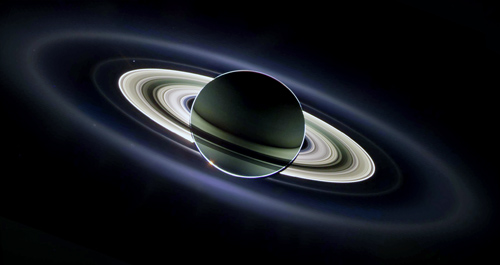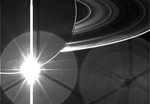By Dr. Mark R. Showalter
Planetary astronomer at the Carl Sagan Center for the Study of Life in the Universe, SETI Institute
 In 1609, Galileo introduced to the world his new invention, the astronomical telescope. It opened up new opportunities to explore a territory that all prior generations had regarded as familiar--the night sky. In short order, he was making major discoveries. But the sky is very big and Galileo's telescope was very small. He had to choose his targets carefully.
In 1609, Galileo introduced to the world his new invention, the astronomical telescope. It opened up new opportunities to explore a territory that all prior generations had regarded as familiar--the night sky. In short order, he was making major discoveries. But the sky is very big and Galileo's telescope was very small. He had to choose his targets carefully.
In that context, Saturn was nothing special, the least of the known planets, just a bright point in a black sky. A year elapsed before he finally peered at Saturn for the first time on July 25, 1610.  Galileo immediately realized that this was something new and different, but he was unable to make sense of the view in his tiny eyepiece. He described Saturn as "triune" in form, mistaking the rings for a planet straddled by two close moons. They resemble Mickey Mouse ears in his sketch. It took the world's astronomers another half-century to figure out exactly what they all were seeing.
Galileo immediately realized that this was something new and different, but he was unable to make sense of the view in his tiny eyepiece. He described Saturn as "triune" in form, mistaking the rings for a planet straddled by two close moons. They resemble Mickey Mouse ears in his sketch. It took the world's astronomers another half-century to figure out exactly what they all were seeing.
 In 1659, Dutch astronomer Christiaan Huygens was the first to describe Saturn's rings as a flat, circular disk, and the concept of a ringed planet first entered the human imagination.
In 1659, Dutch astronomer Christiaan Huygens was the first to describe Saturn's rings as a flat, circular disk, and the concept of a ringed planet first entered the human imagination.
Anyone who has ever looked through a telescope will remember their first view of Saturn. Galileo's other early discoveries retain their allure: the mountains of the Moon, Venus as a waxing and waning crescent, Jupiter with its four little companion moons. But we have seen other mountains, other crescents and other moons. The rings of Saturn remain something different, something truly unearthly.
Galileo's notes and sketches survive from that night in 1610. They capture his thoughts but probably not his emotions. We scientists are taught to write dispassionately, and preferably in the passive voice. "The planet was observed....", not "What the ... is this?!" The interrobang never appears in the scientific literature.

Let me revisit one of the most famous images from the Cassini mission. It was taken a few years ago as Cassini flew through the shadow of Saturn. The view is stunning. A thin fringe of sunlight encircles an otherwise dark planet. The rings, lit from behind, show startling colors and contrasts. Surrounding it all is the faint bluish glow of the fine dust ejected by Enceladus. The picture is a mosaic of smaller images, painstakingly assembled by Cassini's imaging scientists. It is flawless.

On the left side of the mosaic, just above the rings, is a little dot. In the picture it is nothing special, just a bright pixel in a black sky. But we know better. This is planet Earth, seen from the far side of the rings of Saturn. On July 25, 1610, Galileo pointed his hand-made telescope out from Earth to see Saturn for the first time. Four hundred years later, we have a telescope of our own, far more sophisticated but still built by hand, out at Saturn, looking back.
I sometimes wonder if the flawlessness is the problem. When Cassini's images are processed to digital perfection, we unconsciously begin to regard them as the creations of some mad artist at Industrial Light and Magic, not photographs from a real camera orbiting a real planet.
As an amateur photographer, I know what happens when I point my camera toward the sun. I get lens flare, those circles of light that appear in so many of our snapshots from the beach or the ballpark. Too much sunlight bounces around inside the optics, following paths that the lens-makers did not intend, and leaving behind extraneous circles of light on the sensor or film.
 Cassini's cameras are no different, and many of the images from Saturn's shadow show these familiar patterns of lens flare and saturation. These tiles were left out when the mosaic was assembled. However, they reveal a different truth, one not about Saturn but about the camera. It is imperfect. It was built by human hands.
Cassini's cameras are no different, and many of the images from Saturn's shadow show these familiar patterns of lens flare and saturation. These tiles were left out when the mosaic was assembled. However, they reveal a different truth, one not about Saturn but about the camera. It is imperfect. It was built by human hands.
This week, it will be easy to repeat Galileo's experiment. Shortly after sunset, look toward the west and you will see three planets in a line. The brightest is Venus. Above it and to the left is Mars, distinctly reddish but much fainter. And just beyond that, Saturn. Check them out. Any pair of binoculars has lenses far superior to the one in Galileo's invention. But be warned--what you see will not resemble the latest releases from the Cassini mission. If you are very lucky, you might make out Saturn's rings. Or maybe you will just see Mickey's ears. Or maybe just a fuzzy dot. But no matter, because you will be seeing it with your own eyes. That alone ought to be enough to inspire an interrobang or two.
Cassini image credit: NASA/JPL/Space Science Institute
Learn more about the Cassini mission.